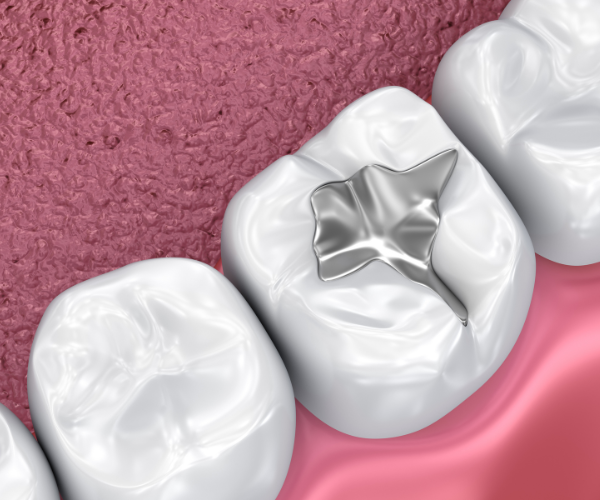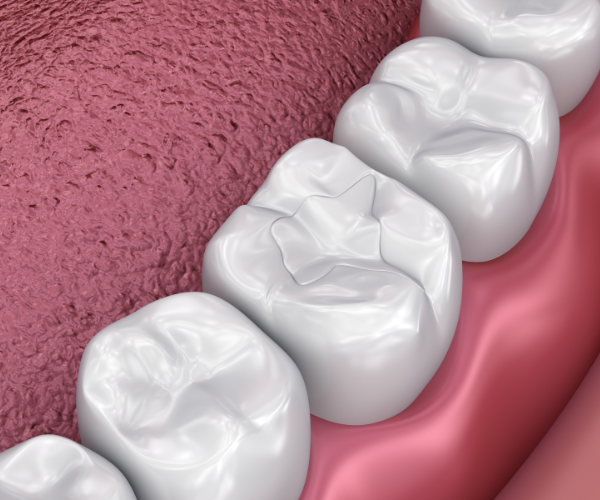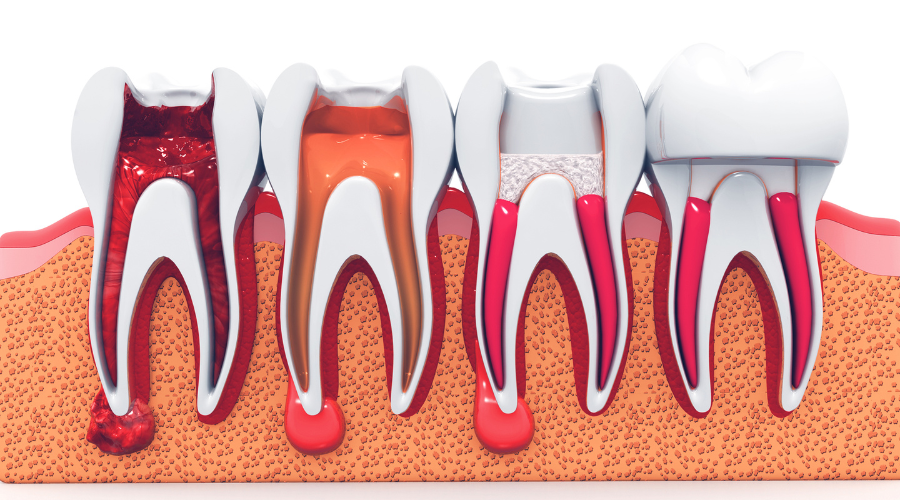GENERAL DENTISTRY
Hygiene
The basis of sound dental care is routine cleaning and maintenance. We customize cleanings on the basis of your periodontal, (gums and bone), health. We utilize medicated gels along with prescription mouth rinses in problem areas if necessary. Ultrasonic scalers are sometimes used to make the procedure more comfortable and effective as well. Sealants should be used as part of a child's total preventive dental care. Dental sealants are thin plastic coatings which are applied to the chewing surfaces of the molars (back teeth). Most tooth decay in children and teens occurs in these surfaces. Sealants cover the chewing surfaces to protect structure. It is an easy three-step process.
Applying sealants does not require drilling or removing tooth structure. A special cleansing liquid, on a tiny piece of cotton, is rubbed gently on the tooth and is washed off. Finally, the sealant is painted on the tooth. It takes about a minute for the sealant to form a protective shield. One sealant application can last for as long as 5 to 10 years. Sealants should be checked regularly, and reapplied if they are no longer in place. Children and adults at high risk of dental decay may benefit from using additional fluoride products, including dietary supplements (for children who do not have adequate levels of fluoride in their drinking water), mouth rinses, and professionally applied gels and varnishes.
Dental Fillings
For hundreds of years, dental fillings have been used to restore teeth. Dental fillings are placed in teeth where a dentist has had to remove tooth structure due to decay or fracture. In recent years filling materials have been substantially improved by technological advancements. Although silver amalgam was the dominant choice years ago, today we have several other preferred options for tooth restoration including tooth colored composite filling materials and cementable resins and porcelains.


Dentures
If you have lost some or all of your natural teeth, dentures can be used to replace your missing teeth - improving your health as well as your appearance. Dentures prevent the sagging of facial muscles, which makes a person with no teeth look much older. Dentures also enable you to eat and speak normally, little things often taken for granted until natural teeth are lost. Brush your gums, tongue, and palate every morning with a soft-bristled brush before you insert your dentures to stimulate circulation in your tissues and to help remove plaque. Regular dental checkups are needed so we can examine your mouth and dentures to ensure a healthy and comfortable fit.
Inlays/Onlays
Dental inlays and onlays are some of the strongest and most lifelike dental restorations available. After your mouth has been anesthetized we prepare the tooth in much the same way we would for a standard filling. When the tooth has been prepared to our satisfaction, an impression is made and sent to a dental lab. You will usually be required to wear a temporary filling until the restoration is fabricated. With proper care, your inlay or onlay will increase your overall health and instill confidence for years to come.
Periodontics
Gum disease is usually caused by plaque, a sticky film of bacteria that constantly forms on teeth. If plaque is not removed with thorough daily brushing and cleaning between teeth, gums become irritated and inflamed. The irritated gum tissue can separate from the teeth and form spaces called pockets. Bacteria move into the pockets where they continue to promote irritation. Left untreated, the process can continue until the bone and other tooth-supporting tissues are destroyed. The early stage of periodontal disease is called gingivitis. It often results in gums that are red and swollen and may bleed easily.
Root Canal Therapy
Endodontic treatment, more commonly known as root canal therapy, is necessary when the pulp of your tooth becomes inflamed or infected. The inflammation or infection can have a variety of causes such as deep decay, repeated dental procedures on your tooth, or a crack or chip in the tooth. With proper care, an Endodontically treated tooth will function normally for years to come.

Wisdom Teeth
Wisdom teeth, or third molars, are the last teeth to erupt in your mouth and are the teeth least needed for good oral health. Most people have four wisdom teeth that usually erupt through the gums in their late teens or early twenties. Sometimes wisdom teeth remain trapped in the jawbone under the gums because there is insufficient room for them to erupt. Wisdom teeth can cause gum disease, crowding or other damage to adjacent teeth, decay (due to the inability of your toothbrush to keep the area clean), and bone destroying cysts. Pain and swelling are the most common symptoms of problem wisdom teeth. Whether you have obvious symptoms or not, it is important to diagnose existing or potential problems caused by your wisdom teeth promptly. Removal is often the wisest decision for your health and well-being.
Snoring
It is estimated that more than 80 million people in North America snore while sleeping. Considering the snorer’s spouse and children, as many as 160 million people are negatively affected by snoring every night. However, there is now a prescription for a more restful night’s sleep. Dr. Fox is the Director of the Park Avenue Sleep Institute and can prescribe an affordable, custom-made device which is flexible, thin and comfortable in the mouth, to aid in the dissolution of snoring. Not only does this device aid in a good night’s sleep, it exhibits documented clinical success for the prevention of annoying and unhealthy snoring.
Bonding
Bonding is a quick, painless in-office procedure to repair cracks, chips, gaps between teeth or cover stained teeth to enhance your smile. Bonding can often be done without anesthesia if there is no decay or pulp exposure. The bonding material is developed in many shades allowing the dentist to accurately match the shade of your natural teeth. The composite resin forms a durable, stain resistant surface that is later smoothed and polished to give it a natural appearance and feel.
Bonding can be used to:
- Protect exposed roots of teeth
- Repair cracks, unevenness, chips
- Close spaces between your front teeth
- Reshape crooked or misshapen teeth
- Replace old or unattractive silver fillings
- Whiten stained teeth
- Replace missing teeth
- Stabilize loose teeth
Biomimetic Oral Care
In 1992, Dr. Fox launched a partnership with the National Institute Of Standards and Technology, ( the largest research facility in the United States) and the American Dental Association. This legendary partnership developed products that revolutionized oral care at the nano tech level. The liquid calcium products that were developed restore, remineralize, strengthen, and harden tooth enamel, stopping cavities before they begin. Dr.Fox employed a team of unique pioneers. Dr. Merrifield with a Nobel Prize in chemistry, Dr. Bhaskar, The Asst. Surgeon General of the United States, Dr. Henry, The Dean of The Harvard School of Dental Medicine, and Dr. Ming Tung, the chief researcher at the American Dental Association. It is now possible, with the evolution of this technology, for dental fillings to be utilized that mimic the physical and chemical properties of teeth and release calcium and phosphate into the tooth structure. The holistic system repairs teeth, chemically bonds, and integrates and seals the fillings. A second application of Dr.Fox's ground breaking research is the application of calcium after a bleaching procedure. The lost calcium is restored to the teeth to seal in the bleach and harden and glaze the teeth. A third application is the remineralization of the teeth at the time of a cleaning. Dr. Fox uses an agent with calcium to polish the teeth and strengthen the enamel.

Book Your Consultation With Dr. Fox Today
Take that first step towards becoming your best self.
Book Appointment